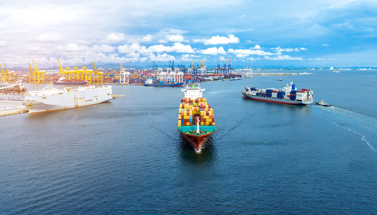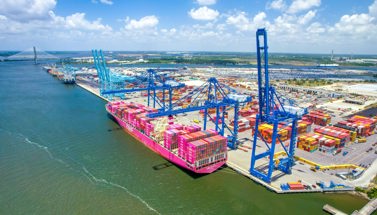
7 Things Every International Freight Shipper Needs to Know
Updated 2/17/2023
Are you ready to grow your business beyond your own borders?
From sourcing markets to an expanded consumer base, manufacturers and brands of all sizes rely on international shipping to support their business. Understanding the fundamentals of international shipping is key to transporting your products around the world with confidence and ease.
In this post, you’ll learn about 7 major factors in international shipping, be linked with key industry resources and offered advice on how to find the best shipping partner for your needs.
1. Transportation Method, Packaging, and Transit Time
How should you transport your product? That depends on the nature of your product, how fast you need it delivered, and how much you are willing to pay.
Transportation Method
If you want your product to arrive quickly, air transport is the best choice but the most expensive. Ocean shipping takes longer but is more affordable. Keep in mind, once your products arrive to their destination by air or sea, they may require drayage or intermodal transport to reach their final location. A freight forwarder will be able to help you map out the best route for your shipment and coordinate the necessary services.
Packaging
For your cargo to remain in peak condition during transit, choose your packaging carefully. Typically, sea cargo is packed in either 20 or 40 ft. dry containers and air freight is boxed or palletized.
But if your product is fragile, perishable, or temperature-sensitive, you will need to consider more specialized options.
Pharmaceuticals and food often require a specific temperature range, such as a refrigerated ISO container.
Hazardous materials are another category that will require additional packaging considerations. All packages with dangerous goods must be labeled to show the type of hazard inside and marked with handling instructions.
Each country also has their own labeling and marking requirements for imports, so be sure to verify what needs to be included beforehand.
Transit Time
Since international shipping involves more factors than domestic, there is greater potential for delays. If you need your product to arrive on a specific date, allow extra transit time to account for possible issues like bad weather or extended Customs clearance.
A good freight forwarder can help you save time by providing expertise on regulations, documentation, and optimal routes for your shipment.
2. Restricted, Banned, or Undeliverable Items
Many seemingly normal goods may be banned imports around the world. Prohibited items include anything from used clothing (Mexico) to sending more than two lithium batteries or four lithium cells at a time (and they must be installed in the device they power).
So be sure to check your destination country’s restricted list to avoid having your goods seized or destroyed by Customs.
Your products could also be undeliverable due to weather, politics, or other circumstances beyond your control. Check for any shipping restrictions or suspensions before you send your goods.
3. Shipping Perishables
There are specific rules for perishable items, depending on which transportation method you use.Examples of perishable goods include flowers, produce, frozen food, and pharmaceuticals.
If you ship by plane, you will be required to comply with the International Air Transport Association’s perishable cargo rules. If you ship by sea, you’ll need to follow regulations set by the International Maritime Association.
You may also need to consider specialized packaging for temperature-controlled goods such as insulation, leak-proof liners, or dry ice.
Another factor to consider when shipping agricultural products is necessary requirements for entry to ensure the product is pest and disease free before entering the destination country.
4. Cargo Insurance
Due to the distance traveled, there is an increased possibility of your cargo getting lost or damaged when shipped internationally. While all carriers are legally required to provide limited liability insurance, it is important to understand its limitations.
Here are some of the downsides of relying on liability coverage to protect your freight:
- The purpose of liability insurance is to protect the carrier, not you as the shipper. Often, you will be responsible for providing proof that the loss or damage to your cargo was the fault of the carrier to get any compensation.
- Liability insurance claims can take months to more than a year to process before you are issued a refund
- Coverage is limited so you will most likely not be refunded for the full value of your cargo
Because of this, you have the option of purchasing additional insurance through a third party. These companies work with you to design custom coverage for your cargo. When you hold your own insurance, you are more likely to recover full value of any lost or damaged cargo and there is a much shorter review time for claims – usually around 30 days.
While it is not required, you should consider purchasing additional coverage if:
- The products you’re shipping are fragile or prone to breaking
- You’re shipping high value cargo
- You don’t want to wait for a liability claim to be processed before being refunded
5. International Trade Documentation
Due to the complex nature of international shipping, there are multiple documents that need to be completed to ensure a successful transit. Even if you enlist the services of a freight forwarder or NVOCC to handle your documentation, you should still understand the basics so you can provide complete and accurate information.
Here are a few pieces of documentation required and their purpose:
Pro Forma Invoice
Parties Involved: issued by the shipper to the consignee
Purpose: A preliminary invoice sent from the shipper to the consignee before the delivery of goods that provides the expected costs, fees, and delivery date. This document helps the consignee avoid any unexpected charges during the exchange.
Commercial Invoice
Parties involved: issued by the shipper to the consignee, used in Customs clearance
Purpose: Shows proof of sale between the shipper and consignee. It is required for Customs clearance because it indicates what taxes and duties are due.
While commercial invoices may vary, this information must always be included, according to U.S. Customs and Border Protection:
- Name and address of buyer and seller
- Detailed description of what is being shipped
- Quantity of goods
- Harmonized System (HS) code
- Value of goods
Packing List
Parties involved: issued by the shipper to the consignee, used in Customs clearance
Purpose: Similar to the commercial invoice, it contains a detailed description of the goods being shipped, like quantity, weight, packaging and dimensions. This document ensures that the items received by the consignee match the items shipped and may be checked for accuracy by Customs officials.
Certificate of Origin (CO)
Parties involved: issued by the shipper, used in Customs clearance
Purpose: States that the goods being shipped were produced, manufactured, or processed in a specific country. This information is used by Customs to determine the duties that should be charged.
The requirements for this document will differ depending on the country you are shipping to, so it is best to verify beforehand.
If your cargo qualifies for reduction or exemption from tariffs under a free trade agreement (FTA), you may be required to submit additional Certificate of Origin documentation to claim these benefits. You can find a list of current trade agreements around the world and the documents required by each of them here.
Shipper’s Letter of Instruction (SLI)
Parties involved: Issued by the shipper to the carrier or freight forwarder
Purpose: The Shipper’s Letter of Instruction provides specific transportation and documentation instructions. It also includes information on the contents of the shipment such as weight, value, and handling.
This document performs several important functions:
- Gives the freight forwarder limited Power of Attorney to act on behalf of the shipper when making decisions involving carriers, ports, insurance, Customs and more.
- Allows the freight forwarder to file Electronic Export Information (EEI) to the Automated Export System (AES).
- Serves as written proof of the carrier’s responsibilities for the shipment.
Bill of Lading (BOL)
Parties involved: Issued by the carrier to the shipper
Purpose: Acts as a legal agreement between the shipper and carrier, detailing the type, quantity, and destination of the cargo being moved. It is also written confirmation that the carrier has received the goods.
Depending on the mode of transportation for your shipment, there are multiple BOL types that may be used:
- Freight Bill of Lading: issued for cargo being transported over the road
- Ocean Bill of Lading (OBL): issued for cargo being transported by sea
- Air Waybill (AWB): issued for cargo traveling by air
There are also terms that specify the ownership rights to the shipment during transport:
- Negotiable Bill of Lading: This agreement serves as a document of title that allows the carrier to transfer the cargo to a third-party during transport. The original carrier transfers ownership by endorsing the back of the bill to the new owner and this process can be repeated as many times as needed.
- Nonnegotiable Bill of Lading: This agreement is not a document of title, and it does not permit the carrier to transfer ownership of goods during transport. At the beginning of the transaction, the shipper agrees to a transportation method (air, sea, over the road) and assigns the cargo to a specific carrier. Upon delivery, the cargo may only be released to the party named on the BOL.
Electronic Export Information (EEI)
Parties involved: issued by the shipper and filed by the carrier to Customs and Border Protection
Purpose: If you are shipping cargo that requires an export license or is valued at more than $2,500, you’ll need to submit the Electronic Export Information (EEI) form through the Automated Export System (AES). This data is used by Customs and Border Protection to confirm export regulations are followed and allows the Census Bureau to track trade statistics.
Special Considerations: Dangerous Goods Declaration
Parties Involved: Issued by the shipper to the carrier
Purpose: If your products are considered dangerous by the International Air Transport Association (IATA) or the International Maritime Organization (IMO), you will need to include a Declaration of Dangerous Goods.
This declaration lists the hazardous materials in the shipment, and verifies that the necessary packaging, identification marks, and labels are included.
To see if your cargo is classified as dangerous, you can reference the International Maritime Dangerous Goods (IMDG) Code and IATA Dangerous Goods Regulations (DGR).
6. Clearing Customs
Custom clearance is the process of having your goods cleared by the local Customs authorities to ensure they meet the country’s regulations and all taxes and duties are paid. No matter which transport method you choose, all international shipments need to go through Customs when leaving the country of origin and reaching the destination.
Customs Regulations
Each country has its own regulations and fees, so consult their Customs website prior to shipping to avoid unexpected delays and expenses.
If you’re not sure where to start, the International Trade Administration (ITA) publishes country commercial guides containing the Customs regulations for countries around the world.
Taxes and Duties
Taxes and duties are both a type of import tax. They are collected when the goods first enter the country and calculated based on the value and type of goods being imported. The responsible party must pay these fees to the local Customs agency before the shipment can be released.
In most cases, the consignee is responsible for paying these fees, but you should agree upon and document these terms prior to shipment.
Customs can be complicated, but the best way to make sure your shipment clears quickly is to provide accurate documentation. If you aren’t sure how to navigate it yourself, an experienced international logistics partner can help guide you through the process.
7. Choosing An International Shipping Expert
If you are a first-time international shipper, shipping large amounts of product or your needs are quite complicated, you may want to delegate the supply chain responsibilities to a logistics provider, freight forwarder, or NVOCC.
An asset-based logistics company owns its fleet of trucks, vessels, and/or planes and coordinates its supply chain.
A freight forwarder is an individual or company that coordinates international transportation on behalf of the shipper through transportation partners. They can also offer services like documentation, filing, and Customs clearance.
A non-vessel operating common carrier (NVOCC) offers ocean-based international container shipping but does not own their own vessel. Instead, they buy or lease spacefrom vessel operating carriers and sell it to shippers.
When you select a shipping expert, make sure they are connected to a network of reliable international partners. Do they understand the specific supply chain needs for your product? Are they committed to providing the best supply chain solutions as you expand globally?
You want to choose a partner who not only offers the expertise to successfully move your freight around the world but someone who cares about supporting the success and growth of your business.

Trailer Bridge and its sister company, Trailer Bridge International, stand ready to partner with you.
Contact UsRelated Articles



Stay Connected
Join the TB community to receive our quarterly newsletter, company updates, and valuable resource guides—created specifically to enhance your supply chain and support your success.

